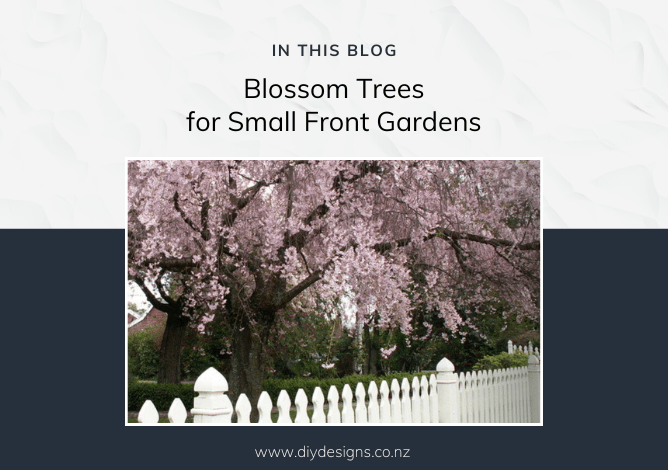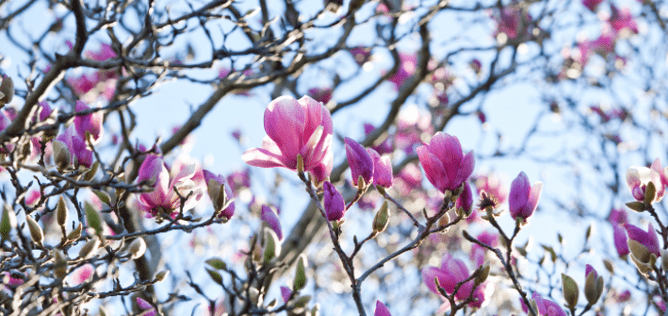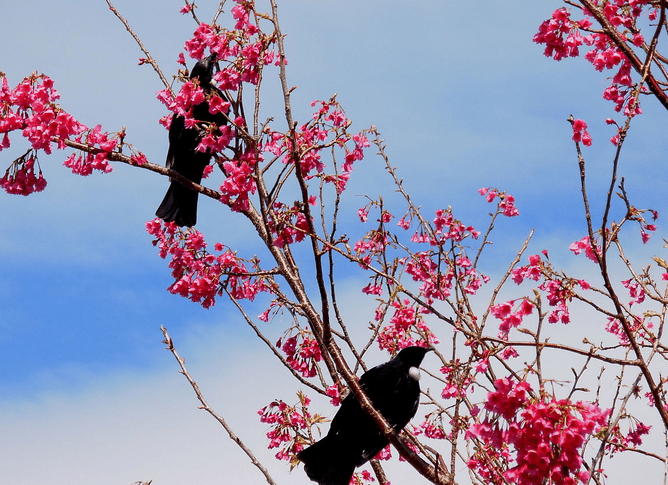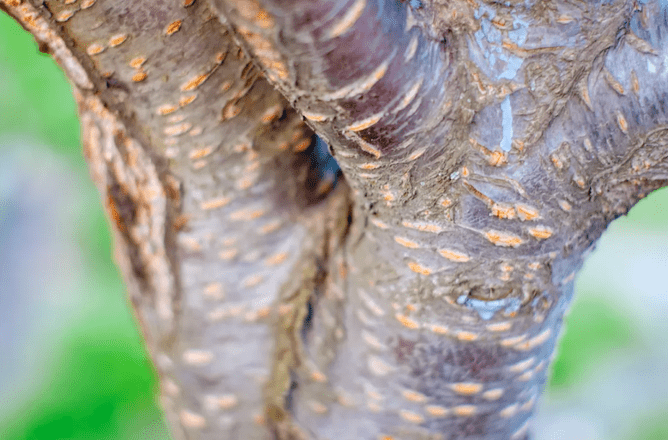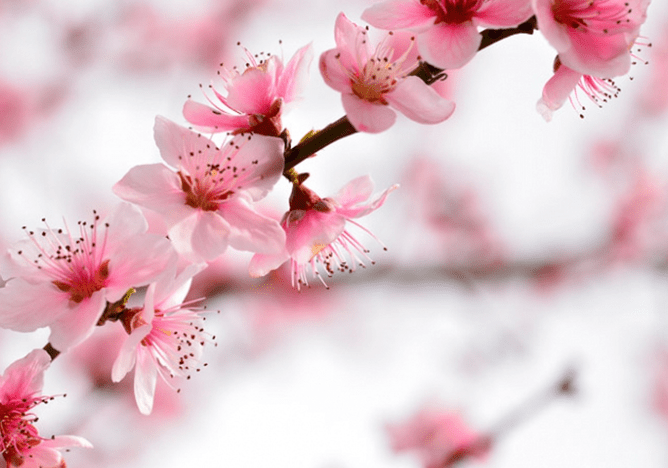Front Garden Design Voyeur
Front gardens bring out the design voyeur in me!
While out walking it’s hard not to snoop at what other Auckland homeowners are doing to smarten up their entrance spaces, as these small front garden spaces can be a landscaping challenge.
What I’m loving currently is that with winter finally receding, and spring upon us, Auckland is bursting into full bloom, or should I say, blossom!
Small Front Garden Blossom Trees
Blossom trees are a popular choice here in Auckland for front garden designs. The pretty blossoms sit as perfectly against the traditional facades of a Mt Eden Villa, Ponsonby cottage or Sandringham bungalow, as they do against the modern architecture of the newer dwellings sprinkled throughout our well-gardened suburbs.
In my local neighbourhood, Titirangi (West Auckland), it's the deciduous magnolia trees that are currently stealing the show.
Sometimes called 'tulip magnolias', the deciduous magnolia differ greatly in appearance from their heavy, evergreen cousins.
Evergreen magnolia (Like 'Little Gem' & Magnolia grandiflora have large white flowers, thick, dark foliage, a dense form.
Deciduous types have softer, paler foliage, open forms and brightly coloured flowers and mostly flower on bare wood.
Because there's no foliage to compete with, the flowers make a stunning spring display adorning the skeletal trees, and there's a huge array to choose from in pink, purple, magenta and white
Magnolia ‘Genie’ and Magnolia ‘ Black Tulip’ are two of my personal favourite magnolias for a small front garden design, due to their small stature (maturing at around 4m and only 2-3m wide), followed closely by Magnolia 'Burgandy Star' which matures at little taller at around 6m
Which Blossom Trees for your Small Front Garden Design?
Prunus (cherry) is another great tree to use in a small front garden design.
Cherry trees have standout ornamental qualities which will enhance any entrance landscape and greatly enhance your arrival zone, as well as add street appeal. And, the nectar-rich blossoms are ideal for attracting nectar-loving birds such as Tui into your garden.
Prunus campanulata is one of the most popular, earliest flowering cherry trees. Hard to miss with its bright pink flowers, it has earned the nickname of 'The Tui Tree' because the Tui flock to them to feast on the nectar-filled blossoms.
For a small front garden, a classic weeping cherry such as Prunus ‘Shidare Sakura ‘ is another popular choice. It has a compact mature size of around 3m x3m, and an easily controlled, weeping form laden with frilly, rich pink, double blossoms in spring.
For those who are stretching the confines of a small city garden, using the front yard to grow edibles is a smart idea. While it's not something you see in the more affluent suburbs like Remuera or Epsom, it is becoming more and more popular in family-friendly suburbs across Auckland such as Point Chevalier, Three Kings & Onehunga, where front-yard fruit trees are now a common sight.
If you want to make better use of your wasted front yard space, you can do it without compromising street appeal by incorporating pretty blossom trees. I say that because these typically have a more attractive form than citrus trees, so they make better front garden specimens. Plum, peach & nectarine are all good choices for the smaller garden.Even the tiniest of gardens has room for a dwarf fruiting such as Prunus persica ‘Honey Babe’, a little peach tree, which has a petite mature size of just 2m x 2m. It'll provide a display of showy pink flowers in spring, followed by sweet juicy peaches ready for feasting in February. ‘Honey Babe’ fruits best when there are other peaches or nectarines nearby for cross-pollination, so try to squeeze in a couple if you can. Prunus persica ‘Nectar Babe’ (nectarine) would be an ideal companion.
Identifying different types of blossoming trees - 5 very easy ways!
To the untrained eye it can be hard to tell cherry, plum, peach, nectarine, apple and crab-apple trees apart.
This is understandable, as many are members of the same plant family (Rosaceae / Rose), and as such, they share similar features and characteristics so identifying what type of tree you have seen blossoming, possibly even in your own garden, can be tricky.
But there are some subtle differences and there are at least 5 very easy ways you can tell blossom trees like apple, plum and cherry, apart.
1. You can identify some blossom tree by their bark
The cherry (Prunus) is the easiest blossom fruit tree to identify by its very distinctive bark, which is a light, silvery grey and has prominent horizontal lines made up of pores called ‘lenticels’.
Young apple trees (Malus) also have conspicuous pores (lenticels), but the bark is more reddish, aging to a greyish-brown, and is quite scaly, thin, and flaky.
Plum is also a prunus. Plum tree bark is a darker colour but lacks the horizontal pore lines (lenticels) of its cousin the cherry.
Peach, which is also another prunus, has bark that is a dark greyish brown colour.
Pyrus (pear) trees have bark that is smooth and silvery grey to reddish brown in colour.
2. You can identify some blossom trees by the way they have been grafted
Cherries and plums are often grafted. This is when two types of tree are mixed for better fruiting or flowering. Grafted trees make an ideal choice for a small garden design, with two-for-one cropping in a limited space.
As the graft placements are different for each, this can be a way of identifying the type of blossom tree you are looking at.
On plum trees, the grafts are placed on the branches and grow in a vertical direction.
On cherry trees, grafts are placed on top of the trunk giving it a distinctive knobbly appearance.
3. You can identify some blossom trees by their shape and form
Plum trees typically have a round or oval shape
Cherry trees tend to have a spreading or ‘umbrella’ form which is wider at the top than at the bottom.
The weeping cherry, as its name suggests, has a pendulous form that is ideal for use as a front garden lawn specimen.
Apple trees usually divide into many large branches low on the trunk, resulting in a canopy of branches and leaves that are usually wider than the tree is tall and they are very twiggy. You need a bit more space for these
Crab-apple trees, which have similar blossoms to apple trees, can make a better choice for a small front garden. They are typically smaller at maturity than apples and can be used for jam and jelly making, or simply used to attract birds to your garden by providing a valuable winter food source. Malus ‘Jack Humm’ is regarded as one of the best crab-apples for the humid climate here in Auckland.
4. You can identify some blossom trees by the timing and colour of flowers and foliage
If you want your front garden to be ahead of the blossom pack, plums are early flowering and plum blossoms often appear even before spring does, bringing welcome cheer to the winter garden.
Plum leaves come out with the flowers, and the leaves unfurl from a cylinder or cigar-like shape and have a simple, alternate leaf arrangement ie the single leaves are not directly opposite each other on the stems. Plum foliage colour varies according to the blossom colour and you will find that pink-blossomed plums have purple leaves, while white-blossomed plum have green leaves.
Cherries are another early flowering tree, and they blossom on bare wood. When the serrated foliage follows, like the plum it has a simple, alternate leaf arrangement ie the single leaves are not directly opposite each other on the stems, however, it is attached to the branch by a short red stem (petiole). The foliage is usually green or initially copper-coloured turning green, the exception being the sand cherry. The sand cherry has a very similar appearance to a purple-leafed plum. and is a small blossom tree ideal for exposed or dry front garden situations.
Malus (apples and crab-apples) typically flower later in spring. Apple trees have green foliage however crab-apples can have green leaves, or ornamental shades of purple. Malus foliage has an oval shape and they have serrated edges appearing as either as simple or multiple alternate arrangements on the branches.
Peach foliage is also oval and presents in an alternate arrangement similar to malus species, however, the leaves are much longer, up to 10cm + in length, and the serrated leaf edge is very fine.
5. You can identify some blossom trees by their petals and arrangement, as well as their colour.
If it's in flower, you can identify your blossom tree type by looking closely at the blossoms, including how they are arranged on the branches of the tree. If you study the shape of the petals, you will see that the petals of plum, cherry, peach, apple, and crab-apple all have unique visual characteristics, making them pretty easy to tell apart.
Cherry blossoms have a small cleft (indent) at the tip of their petals and this gives the petals a distinct heart-like shape. Cherry blossoms are always pink or white, and have long stems that attach the blossoms to the branch. Buds are oval.
Plum blossoms have rounded petals. The buds are also round and sprout close to the branch itself, so the blossoms, be they pink, white or that distinctive purple, come directly off the branch and have no stems at all.
Peach blossoms have teardrop shaped petals, often in vivid shades of pink. Even those of palest pink will have a distinct deep magenta center. Peach blossoms have much shorter stems than cherry and plum and are distinct because of the way they feature two flowers sprouting from the same branchlet. Buds are grey and typically fuzzy.
Apple blossoms have five petals. Buds are set at the terminal end of 4-inch or longer shoots, or on shorter branches called spurs.
6. Take time to smell the blossoms
Still not sure?
Take a sniff. Plum blossom is very fragrant whereas the earlier flowering cherries typically have little to no fragrance. Some mid-season cherry cultivars can be very fragrant, often with an almond scent. Apple blossoms produce a sweet scent that is faintly reminiscent of apple fruits. Peach blossom has a mild, sweet aroma reminiscent of honey and almond.
Want To Learn More Tips For Your Garden Design?
If you're feeling more knowledgeable about blossom trees and gardens in general after reading this blog, just imagine the garden & planting tips and tricks you could pick up in our info-packed eBook!
It's a must-read if you want to improve your garden without overspending because there are 10 common mistakes people make when designing gardens, heck, even some professionals make these mistakes; and they are most likely the reason you're not satisfied with how your garden looks and feels.
What are they and how do you fix them? FIND OUT HERE
Prefer 1:1 Help with Your Small Garden Design?
Need help choosing trees for your front garden or just need design help in general? DIY Designs is an Auckland-based landscape design company, working online to provide professional garden design services at a very affordable price.
